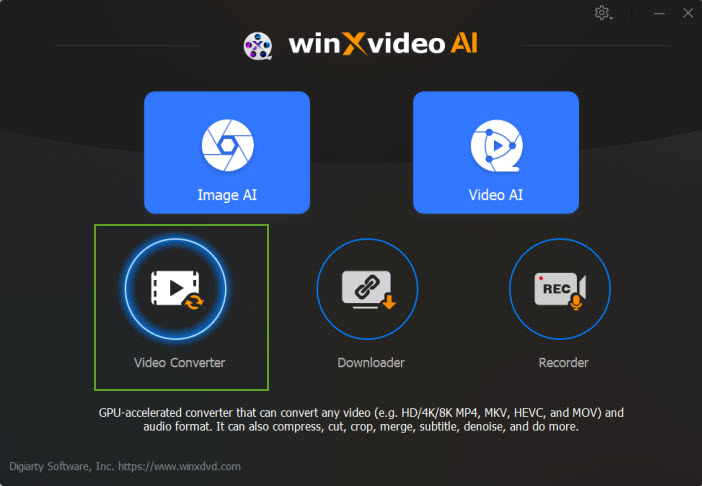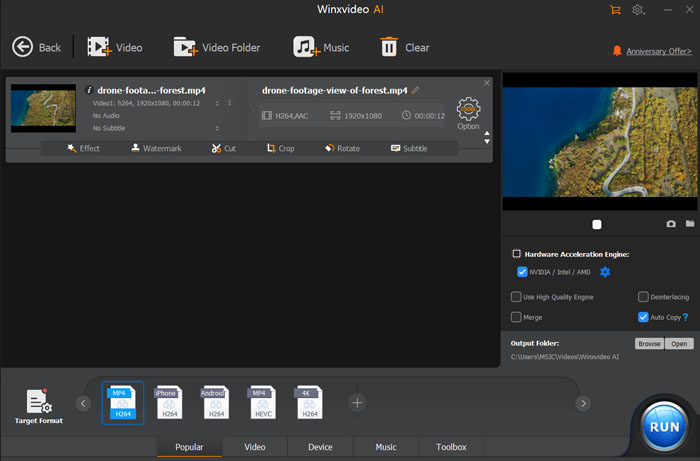Apple AV1: Apple Finally Supports AV1 Hardware Decoding in M3 Chip
With the release of M3, M3 Pro and M3 Max, Apple finally supports AV1 hardware decoding on the new MacBook Pro and iMac. Together with the news that A17 also supports for AV1 codec on iPhone 15 Pro and iPhone 15 Pro Max models, Apple has a full support for AV1 hardware decoding. This means that users can have a higher compression rate than H.265/264/VP9 under the same picture quality, that is, the same bandwidth can transmit a higher definition of the picture quality. For example, AV1 codec provides more efficient and high-quality video experiences from streaming services.
But this is not the end yet. This article covers everything you need to know about Apple AV1 support, including the significance for Apple to support AV1, and how to play videos in AV1 codec on eariler models of iPhone, iPad, MacBook, and iMac etc.
Table of Contents
Part 1. What's the Significance of Apple Supporting AV1?
Apple takes a leap forward in video technology with AV1 codec support, marking a pivotal moment in the world of video streaming and playback, especially for multimedia enthusiasts and tech aficionados. To be specific, what users can benefit from Apple supporting AV1? You can find some clues here.
1. More Efficient Compression:
AV1 is an open standard video codec designed to deliver more efficient video compression, resulting in smaller file sizes and higher visual quality. Supporting AV1 decoding on Apple means that, at the same visual quality, video files can be smaller. This is a significant benefit for users of online video streaming and downloadable content, promising a notable improvement in their viewing experience. More for the difference between AV1 and HEVC >>
2. Bandwidth and Data Savings:
The efficient compression of AV1 implies that higher quality videos can be transmitted under the same bandwidth, or equivalently, bandwidth can be conserved when using videos of the same quality. This is particularly crucial for users in regions with limited network bandwidth and for those on mobile devices.
3. A More Comprehensive AV1 Ecosystem:
Since the release of AV1, leading hardware manufacturers in the industry, including Intel, AMD, NVIDIA, MediaTek, and others, have successively joined the ranks of supporting AV1 hardware decoders. Beyond hardware ecosystems, numerous video playback software and platforms have announced their support for AV1 video playback, with video content providers actively increasing the volume of AV1-encoded content. Now, Apple has announced its support for AV1 hardware decoding. With this development, mainstream mobile devices and browsers now offer comprehensive support for AV1, solidifying the standard's ecosystem.
4. Support for High Resolution and Enhanced Visual Quality:
AV1 not only excels at low bitrates but also supports higher resolutions and superior visual quality. This is essential for devices and services that cater to high-definition and ultra-high-definition video content.
In summary, Apple's adoption of AV1 decoding not only enhances the efficiency and quality of video playback but also propels the global adoption of this advanced video encoding and decoding standard.
Part 2. How to Play AV1 Videos on Eariler iPhone iPad and Mac?
While Apple's latest M3 and A17 chips have announced support for AV1 hardware decoding, they are currently only integrated into the newest iPhones and Mac computers. However, a significant portion of Apple users still owns older iPhone, iPad, and Mac models that do not support AV1. How can AV1 videos be played on these devices?
The best solution is to use Winxvideo AI to convert AV1 videos to HEVC or H.264. This software not only facilitates the conversion of any video to Apple-supported MOV, MP4, or M4V formats, whether using HEVC or H.264 encoding, but also allows users to directly convert videos for specific iPhone, iPad, and Mac models.
Moreover, Winxvideo AI is a remarkable AI-powered image and video enhancer. If your AV1 videos are poor in quality, for example with shakiness,low resolution or jitter, it can help you stabilize, upscale and boost FPS of AV1 video for a seamless playback on your computer.
Let's check how to convert AV1 to Apple-supported HEVC/H.264 using Winxvideo AI.
Step 1: Free download Winxvideo AI and launch it. Click on the "Video Converter" icon on the main interface. This will lead you to video converting window.

Step 2: Drag and drop, or click "+Video" button to import your AV1 unplayable videos.
Step 3: Select "MP4 HEVC" or "MP4 H.264" as the output from the "Target Format" section at the bottom of the window. Or you can also directly click on the "Device " column to choose the iPhone, iPad or Mac model preset profiles.

Step 4: Check the destination folder and tap the "RUN" button to start converting AV1 to MP4, MOV or iPhone, iPad or Mac.
Tips: Depending on where you want to play your output videos (players/browsers in PC, smart phone or tablet), there are different codec standards(VP8,VP9,HEVC,H.264 etc.) which are designed to be best compatible with your electronic devices. On the Settings interface, you can also adjust some other parameters in video and audio options. By the way, the top stuff (Output Profile) is clickable if you are not satisfied with H.264 codec.
What You May Also Interested In: What's AV1 Codec & How to Encode AV1 Video
Part 3. FAQs
1. Can iPhones plays AV1?
The initial Apple products to feature official AV1 codec support are the iPhone 15 Pro and iPhone 15 Pro Max. These devices are equipped with the latest A17 Pro chip, specifically designed to accommodate AV1 video through a dedicated AV1 decoder.
2. Does Apple M2 support AV1?
No. The M2 processor from Apple lacks dedicated hardware acceleration for the AV1 codec, making it less optimal for tasks related to AV1 video encoding and decoding. However, Apple's subsequent M3 processor addresses this limitation by incorporating AV1 hardware decoding support.
3. Is AV1 better than HEVC?
It depends. AV1 and HEVC (H.265) are both advanced video codecs designed to achieve efficient video compression while maintaining high visual quality. The choice between AV1 and HEVC depends on various factors, and each codec has its strengths and weaknesses. AV1 is often considered better than HEVC in terms of compression efficiency and the open-source, royalty-free model.
4. Is AV1 lossless?
AV1 is primarily designed for lossy encoding, with the additional capability of supporting lossless compression.





















